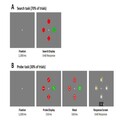Abstract
In capture-probe paradigms, probes presented in salient distractors are less frequently recognized than probes in non-salient distractors. This probe-recognition frequency effect could be due to attention going less frequently towards the salient distractors (proactive suppression) and/or dwelling more shortly on the salient distractors (reactive suppression). However, the probe- recognition frequency effect was considered as evidence supporting only proactive suppression based on the probe-recognition assumption where if attention is directed towards the probes, their correct identification should occur irrespective of whether attention disengages quickly or slowly. The present study revealed less accurate probe-recognition in the salient than non- salient distractors, inconsistent with the assumption and consistent with reactive suppression. To examine proactive suppression despite the assumption invalid, we measured how frequently the probes were attended by asking participants to always attempt the probe tests wherever they saw them, irrespective of whether they were able to recognize the attended probes or not. This probe-detection frequency showed less frequent attention towards the salient than non- salient distractors. The present findings suggest that proactive suppression is evident even if the probe-recognition assumption is not evident, and proactive and reactive suppression operate in concert to reduce the processing of distracting information.
